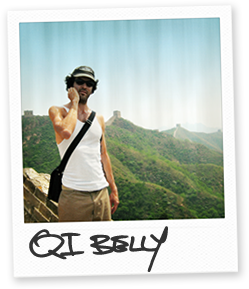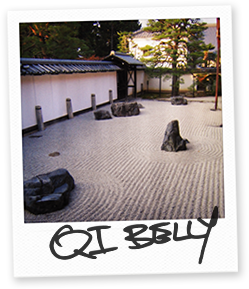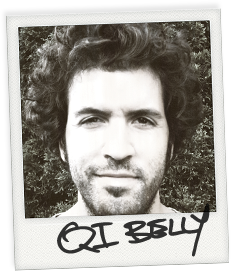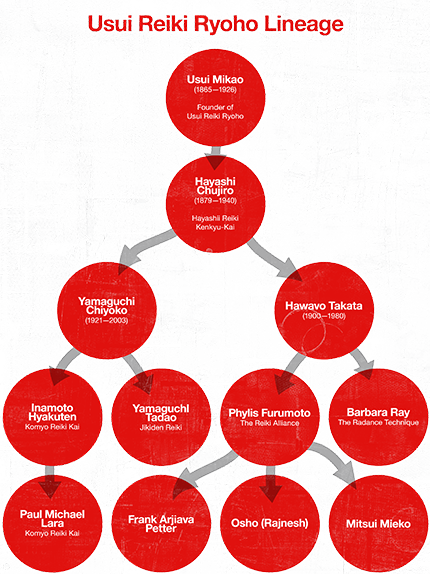My Bio
It was during university that I began studying meditation.
At the time, I was just looking for answers. I was a stressed out 20 year old (psychology student) with all the dramas of relationships, work and maintaining a high academic standard. With graduation on the horizon, I knew I needed a change. I didn’t like where I was headed.
Meditation opened the floodgates for me. I began reading up on the subject and was fascinated in particular with Daoist and Buddhist literature. Upon graduation, I left my native California to travel and further my studies. Like anyone that age, I just wanted to be free. Free from the constraints of society and free to create my life as I wanted. Within a year I found myself living in the Czech Republic. It was there that I first began training QiGong (strange, I know). Just like seated meditation, I was hooked. I practiced like a fiend, amazed at how much more interesting life was becoming.
As time went on, I went from Europe to Asia. Traveling, studying and taking in as much as possible, I couldn’t get enough. In 2004 I moved to Japan. Studying Zazen (Zen Meditation), Reiki, and QiGong in Kyoto was nothing short of amazing. The history, the discipline, the beauty – mind blowing. But there was something about all of it that sparked my interest in China. So, after 3 years in Japan, I moved to Beijing to deepen my practice.








Chaotic and heavily polluted, China was the Wild West compared to my life in Kyoto. Growing up as a martial artist (Shotokan Karate), I thought I would know what to expect in terms of training. But the Chinese Kung Fu was not what I thought. People often ask about my daily routine in China (4-5 hours of training per day) and say, ‘Oh, it must have so nice!’ or ‘My, how lucky you must have been.’ But let me tell you, it was brutal. Master Zhang Yu Fei was crazy demanding. I don’t think he was nice to me, even once, for the first year. But I stuck it out. And he came around – in a big way.
Thinking back over my travels always puts a smile on my face. Immersed in Asia for over 7 years, I learned a lot about myself. Strange how we sometimes have to uproot in order to find out who we really are.







These days my practice looks very different than it used to be. Sitting on a top of mountain in Kyoto and feeling one with the universe was easy in comparison to my life now. Here in Toronto, I work at maintaining that awareness in the streets and at home with my family. Tai Chi, Meditation, Reiki and QiGong changed my life, but they were never the point. Beyond category and limitation, I studied these practices to become free from habits that no longer served me.
Komyo Reiki Lineage

Paul Lara teaches Komyo Reiki Do and is a 5th generation lineage holder under the Japanese line of Usui Sensei. Paul’s teacher, Inamoto Hyakuten Sensei is a lay Buddhist monk and the founder of Komyo Reiki Kai. Hyakuten Sensei lives in Kyoto, Japan where he was initiated into Shinpiden by Yamaguchi Sensei.
Paul practiced under Hyakuten Sensei for three years, while I was living and working in Kyoto, Japan, the birthplace of Reiki. Here in Canada, Paul Lara is certified under The Canadian Reiki Association as a Practitioner and Teacher.
As a discipline, Komyo Reiki places upmost importance on personal spiritual transformation. Reflective of Usui Sensei, Komyo Reiki is a system designed as a path towards enlightenment.
Meditation Timeline
Paul Lara has been practicing meditation for 3 decades. He was properly introduced to Zen at the venerable Thich Nhat Hahn’s monastery in France. There Paul studied and worked for 2 months with him and his Vietnamese Buddhist community.
His formal training is in Japanese Zazen under Abbot Taiun Matsunami of Ryosen-An, Daitokuji Temple in Kyoto, Japan. Originally founded in 1315 and rebuilt in 1955 by Ruth Fuller Sasaki, this Rinzai temple was a prominent piece in the introduction of Zen Buddhism in North American culture. Sasaki made history by being ordained a priest and installed as abbot of Ryosen-An, which she declared as an extension of the First Zen Institute of North America, New York. As a matter of fact she was a mentor to Gary Synder and Philip Yampolsky, and frequently entertained such guests as Allen Ginsberg, Joseph Campbell and R.H. Blyth. As well, Ruth Fuller Sasaki was Alan Watts’ mother-in-law.
Paul was fortunate enough to study at Ryosen-An under Matusnami San for 3 years while living and working in Kyoto.
While living in Beijing, Paul continued to deepen his Zen practice. In China it’s called Chan. Zen came from Chan. While there, Paul changed his practice dramatically. He began standing practices by holding postures for long periods of time. There he was introduced into Nei Gong (internal practice) and completed a 100 Day Meditation exercise under Master Zhang Yu Fei. The practice consisted of 2 hours of sitting per day for the purpose of refining essence into qi, thus building the foundation for the microcosmic circuit.
However Paul’s personal practice has grown over the years to include various forms and applications.
QiGong & Tai Chi Lineage
Paul Lara teaches Hun Yuan San Shou and was instructed individually under Master Zhang Yu Fei while living and working in Beijing, China for 2 years. It was in Beijing, that he was inducted into the Chen Style Xin Yi Hun Yuan Tai Chi family and became an official 20th generation lineage holder, as well as a 3rd generation lineage holder in Hun Yuan QiGong.
Hun Yuan San Shou

Zhang Yu Fei, was born in 1955 in Zhang Jia Kou, Hebei Province. As a child he studied Ba Ji Quan and Xing Yi Quan under Master Fan Bing Shan. Later, while attending college in Henan Province, he studied Xin Yi Liu He, San Shou and various weapons under Master Ding Hong Kui. He eventually moved to Beijing where he followed Hun Yuan Tai Chi Quan Master Feng Zhi Qiang for over twenty years. He was also privileged enough to practice Da Cheng Quan under Master Wang Xuan Jie, a famous fighter in BeiJing, this greatly helped improve his skill level. He has extensively researched Chinese philosophical literature and traditional Chinese medical literature, and is an accomplished painter and calligrapher.
Feng Zhi Qiang was born 1928 in Hebei Province. As a child he learned Tong Zi Gong (stretching) and Zhan Zhuang (standing exercises). At a young age he moved to BeiJing and studied Tong Bei boxing. When he was 20 years old he began studying Liu He Xin Yi under Hu Yao Zhen, who emphasized methods of gathering and nourishing Qi, practicing intention, San Ti standing, Dan Tian methods, and boxing postures. Feng later trained under Chen Fa Ke and eventually became one of his main students. Chen Fa Ke’s popularity encouraged others to come forth and challenge both him and his student. Feng would often take on the challengers. Feng accomplished an incredible feat, he defeated all challengers usually without badly injuring them. In 1981 Feng Zhi Qiang retired and in 1983 became the president of the Beijing Chen style Tai Chi Quan Research Association that was established the same year.


Ding Hong Kui (1895-1986) studied under many masters including Wang Shaocheng and Jiang Dianchen. He lived and trained on Snake Hill, Hubei Province, where he continued teaching many students until his death in 1986 at the age of 92. He was well known for his mastery of Tang Quan and his free fighting abilities.
Hu Yao Zhen (1879-1973) was a native of Shanxi Province. He was well known as a martial artist, QiGong expert and traditional Chinese Medicine Doctor. He also received ‘secret ransmissions’(exclusive teachings) of Buddhist and Taoist meditation, which gave him an edge on his opponents. It was Hu YaoZhen who introduced Feng Zhi Qiang to Chen style master Chen Fa Ke in order to further his studies.


Chen Fa Ke (1887-1957) was born in Chen Jia Gou, Henan Province. Well-known for free fighting victories in his hometown, he then traveled to BeiJing in 1929 to teach Tai Chi Quan. He soon was renowned for defeating many opponents without badly injuring them. In his later years he modified the original Chen form (Lao Jia), which then became the foundation for the Chen New Frame form (Xin Jia).